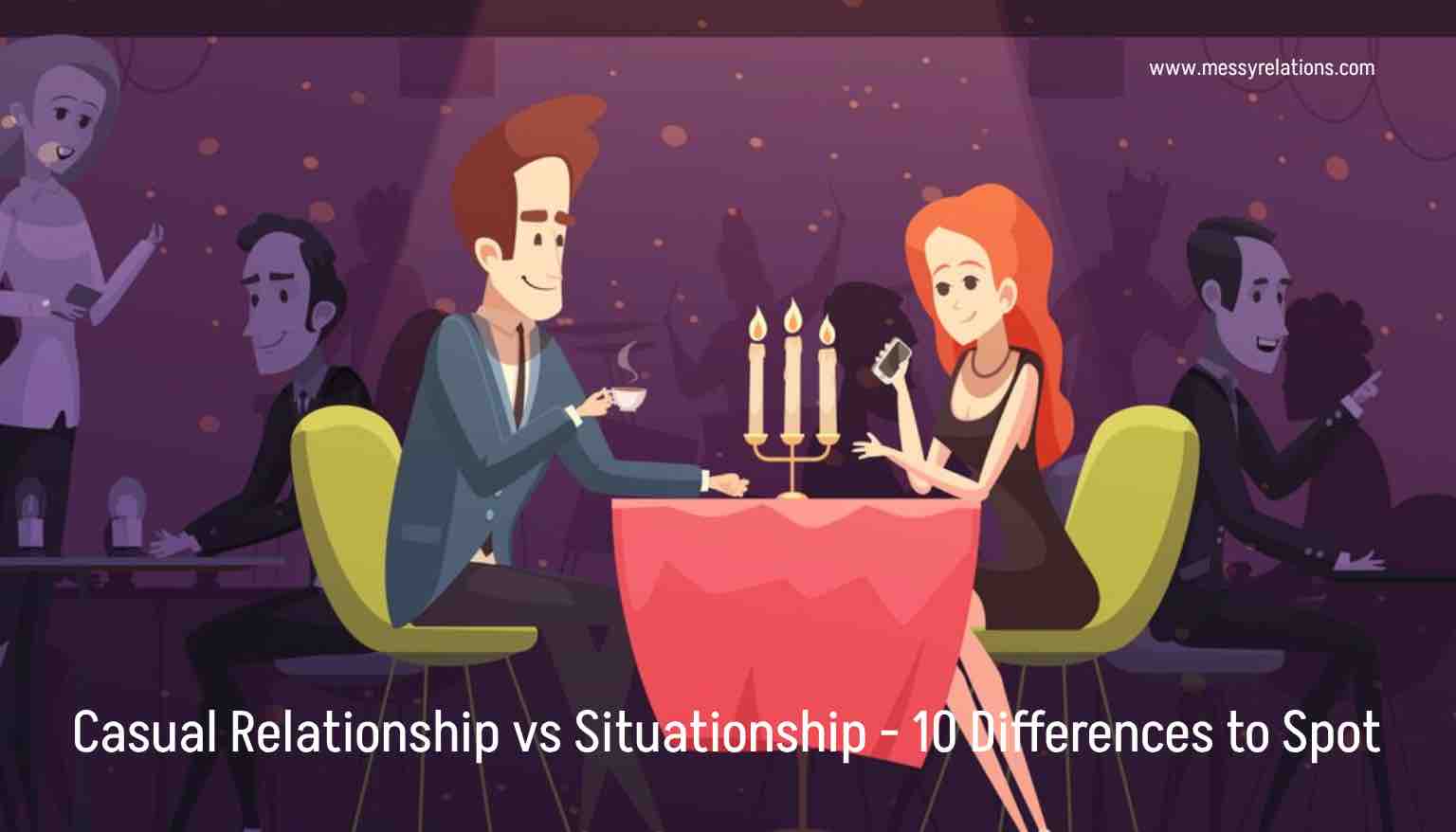In the ever-evolving landscape of modern dating, distinguishing between a casual relationship and a situationship can be as intricate as navigating the relationships themselves. Understanding the differences is crucial for those navigating the dating world. This article delves into the 10 key differences between a casual relationship and a situationship, shedding light on this often confusing topic.
1. Expectations in Casual Relationship & Situationship
Casual Relationship: Typically, a casual relationship is defined by its lack of commitment and seriousness. Partners may enjoy each other’s company and may be physically intimate, but there’s no expectation of a future together or a deep emotional connection.
Situationship: In contrast, a situationship often lacks a clear definition but usually involves more emotional investment than a casual relationship. There’s an element of ‘going with the flow,’ but with unspoken and often undefined expectations about the future.
2. Emotional Depth
Casual Relationship: Emotional depth is usually minimal in a casual relationship. Conversations tend to be light, and personal sharing is limited.
Situationship: Situationships, on the other hand, tend to involve deeper emotional connections. Conversations can be more intimate, with both parties sharing personal thoughts and feelings.
3. Duration and Consistency
Casual Relationship: These relationships are typically short-lived and can be sporadic in nature.
Situationship: Situationships can last for months or even years, often with a regular pattern or routine that mimics traditional relationships.
4. Communication
Casual Relationship: Communication in a casual relationship is often limited and predominantly focused on arranging meet-ups.
Situationship: In a situationship, communication is more frequent and varied, including daily check-ins and discussions about life in general.
5. Future Planning
Casual Relationship: Future planning is typically absent in casual relationships. Plans are made spontaneously and usually only a few days in advance.
Situationship: While not always the case, situationships may involve some level of future planning, albeit without clear commitment.
6. Public Acknowledgment
Casual Relationship: Partners in a casual relationship may avoid public acknowledgment of their connection.
Situationship: In a situationship, there might be more openness to appearing in public together or even meeting each other’s friends.
7. Physical vs Emotional Intimacy
Casual Relationship: Physical intimacy is often the cornerstone of a casual relationship, with less focus on emotional bonding.
Situationship: While also potentially physically intimate, a situationship usually includes an emotional aspect that goes beyond physical closeness.
8. Expectations and Clarity
Casual Relationship: Expectations are typically clear in a casual relationship – it’s understood to be non-serious and non-exclusive.
Situationship: Situationships are often marked by a lack of clarity, with both parties possibly having different expectations and hopes.
9. Involvement in Each Other’s Lives
Casual Relationship: There is usually minimal involvement in each other’s lives outside of the relationship.
Situationship: Situationships might involve a greater degree of involvement in each other’s daily lives and personal challenges.
10. Ending the Relationship
Casual Relationship: Ending a casual relationship is typically straightforward due to the lack of deep emotional attachment and commitments.
Situationship: Ending a situationship can be more complex and emotionally challenging, similar to ending a more defined relationship.
Understanding the nuances between a casual relationship and a situationship is key for anyone navigating the contemporary dating scene. Recognizing these differences can help you manage your expectations and emotional investments, leading to healthier and more fulfilling connections. Remember, every relationship is unique, and it’s important to communicate openly and honestly with your partner to ensure mutual understanding and respect, regardless of the type of relationship you are in.
| How to End a Casual Relationship? | How to End a Situationship? |
Going through the end of a casual relationship can be a delicate process. Whether it’s a mutual understanding or a one-sided decision, ending it respectfully and clearly is key. Here’s a guide on how to effectively and considerately conclude a casual relationship. 1. Reflect on Your Decision Begin by reflecting on your reasons for wanting to end the relationship. Ensure that your decision is based on your personal needs and feelings, and not external pressures. 2. Choose the Right Time and Place Find an appropriate time and place to have this conversation. A private, quiet setting is ideal. Avoid public places or moments of high stress or emotion. 3. Be Honest and Direct Honesty is crucial. Be clear about your feelings and why you want to end the relationship. Avoid vague statements that might leave room for misinterpretation. 4. Use ‘I’ Statements Focus on your feelings and experiences using ‘I’ statements. This helps in taking responsibility for your decision without placing unnecessary blame on the other person. 5. Listen to Their Perspective Be prepared to listen. The other person might have questions or emotions they want to express. Active listening shows respect and compassion. 6. Avoid Unnecessary Details Keep the conversation focused on the main points. Over-explaining or delving into unnecessary details can complicate the discussion. 7. Offer Closure If appropriate, discuss what led to your decision. This can provide closure for both parties, making it easier to move on. 8. Respect Their Reaction Be prepared for any reaction, whether it’s sadness, confusion, or anger. Respect their feelings and give them space to process the news. 9. Stay Firm in Your Decision If you’re certain about ending the relationship, stay firm in your decision. It’s kind to be empathetic, but also important to not give mixed signals. 10. Take Time for Yourself After ending the relationship, give yourself time to reflect and heal. Regardless of the relationship’s casual nature, it’s normal to need time to adjust. Ending a casual relationship thoughtfully can prevent unnecessary hurt and confusion. It’s about balancing honesty with compassion and ensuring that the end of the relationship is as respectful as its beginning. | Ending a situationship, with its undefined nature and emotional intricacies, can be challenging. It requires a sensitive and clear approach to navigate the emotional complexities involved. Here’s a guide on how to end a situationship in a respectful and effective manner. 1. Understand Your Feelings First, be clear about why you want to end the situationship. Understanding your feelings and reasons will help you communicate more effectively. 2. Prepare for the Conversation Plan what you want to say. It’s helpful to jot down key points you wish to convey to avoid getting sidetracked during the conversation. 3. Choose an Appropriate Setting Have the conversation in a private and comfortable setting. This ensures both of you can express yourselves freely without external pressures. 4. Communicate Clearly and Honestly Use clear, direct language to express your feelings. Honesty is crucial in conveying why the situationship isn’t working for you. 5. Acknowledge the Relationship’s Value Recognize and appreciate the time spent together. Acknowledging the positive aspects of the situationship can soften the blow. 6. Listen to Their Side Be prepared to listen and validate their feelings. They might have their own views and emotions about the situationship that need to be heard. 7. Avoid Blame Focus on your feelings and experiences rather than placing blame. Using ‘I’ statements can help in communicating your perspective without making the other person feel at fault. 8. Be Compassionate but Firm While it’s important to be compassionate, also be firm in your decision. Ambiguity can lead to more confusion and hurt. 9. Discuss Post-Breakup Boundaries If necessary, discuss post-breakup boundaries, especially if you share the same social circles or workspaces. 10. Allow Time for Processing Both you and the other person might need time to process the end of the situationship. Give each other space and respect each other’s process of moving on. Ending a situationship respectfully involves clear communication, empathy, and a thoughtful approach. It’s about honoring the connection you shared while acknowledging that moving on is the healthiest decision for both parties. |
FAQs on Casual Relationship vs Situationship
1. How to tell if I’m in a casual relationship or a situationship?
To discern whether you’re in a casual relationship or a situationship, consider the level of emotional involvement and future expectations. A casual relationship typically involves minimal emotional depth and future planning, focusing more on physical connection. In contrast, a situationship often includes deeper emotional bonds and may have unspoken expectations about the future, despite lacking a formal label.
2. What are the main emotional differences between a casual relationship and a situationship?
The primary emotional difference lies in the depth of connection. Casual relationships usually keep emotional involvement to a minimum, focusing on physical enjoyment and spontaneous interactions. Situationships, on the other hand, often involve more significant emotional connections, including sharing personal thoughts, feelings, and daily life details.
3. How long do casual relationships and situationships typically last?
Casual relationships often are short-term and can end as quickly as they begin, focusing on immediate gratification. Situationships can vary in duration, often lasting several months or even years, as they evolve more organically without clear boundaries.
4. Is it common for a casual relationship to evolve into a situationship?
Yes, it’s possible for a casual relationship to evolve into a situationship. This transition usually happens when both parties start developing deeper emotional connections and begin integrating more significantly into each other’s lives, even without formal commitment.
5. Can a situationship have clear communication like a traditional relationship?
Clear communication is possible in a situationship, but it often requires more effort. Unlike traditional relationships where expectations are usually well-defined, situationships might need more open and honest discussions to navigate the unspoken and undefined nature of the connection.
6. Are future plans discussed in casual relationships or situationships?
Future plans are less likely to be a topic of discussion in casual relationships due to their focus on the present. In situationships, future plans might be discussed, but often without the certainty or commitment that comes with more defined relationships.
7. How do casual relationships and situationships differ in public acknowledgment?
In casual relationships, public acknowledgment is often avoided, keeping the relationship discreet. Situationships might involve more openness, including appearing in public together or meeting friends, albeit without the formal recognition of a committed relationship.
8. What’s the process of ending a casual relationship compared to a situationship?
Ending a casual relationship is typically straightforward due to its non-committal and emotionally detached nature. Ending a situationship can be more complex and emotionally challenging, akin to breaking up in a more defined relationship, due to the deeper emotional ties involved.
9. How should I approach a situationship if I want more commitment?
If you desire more commitment in a situationship, the best approach is to have an open and honest conversation about your feelings and expectations. It’s important to express your desires clearly and to understand that the other person’s response may vary.
10. Can the boundaries of casual relationships and situationships change over time?
Yes, the boundaries of both casual relationships and situationships can evolve over time based on mutual feelings and conversations. It’s important to continually communicate and reassess the relationship to ensure it aligns with both parties’ needs and comfort levels.




